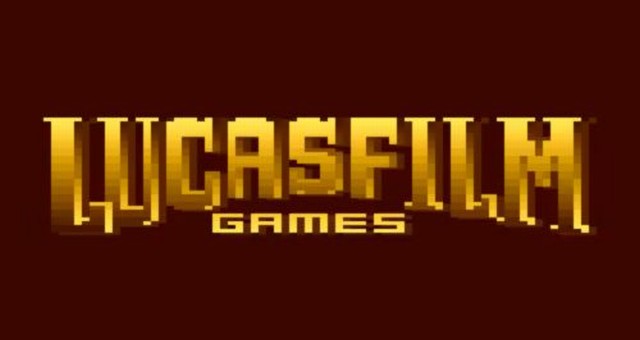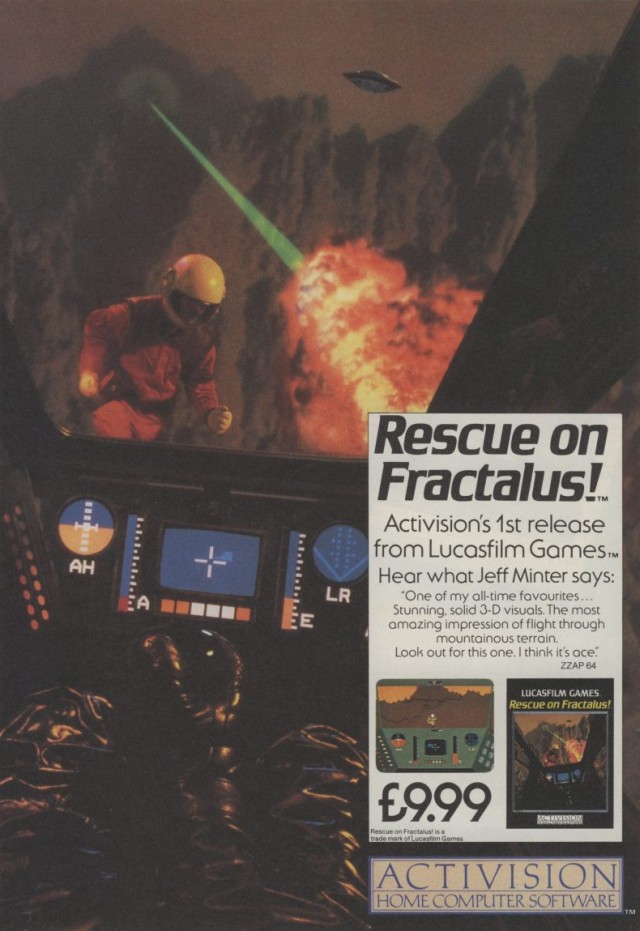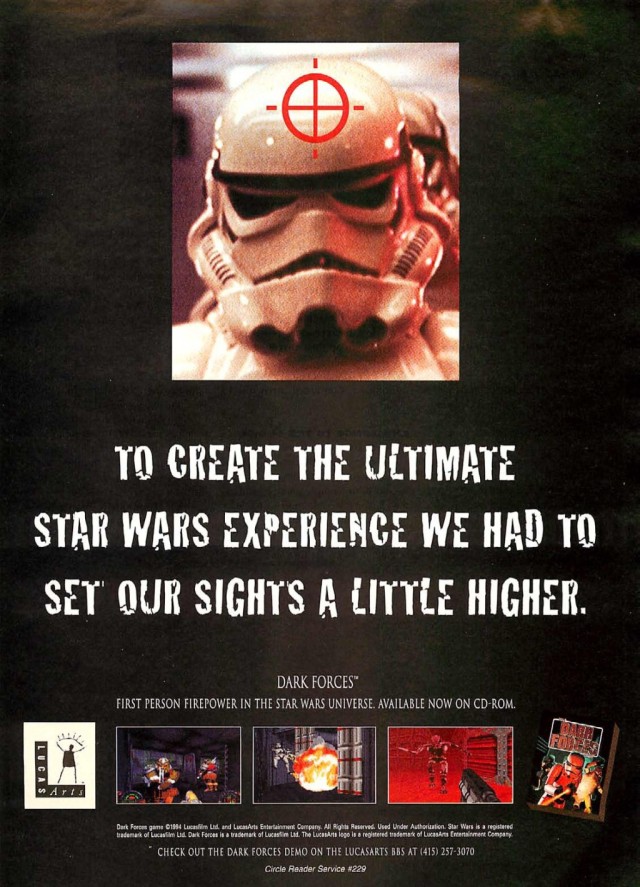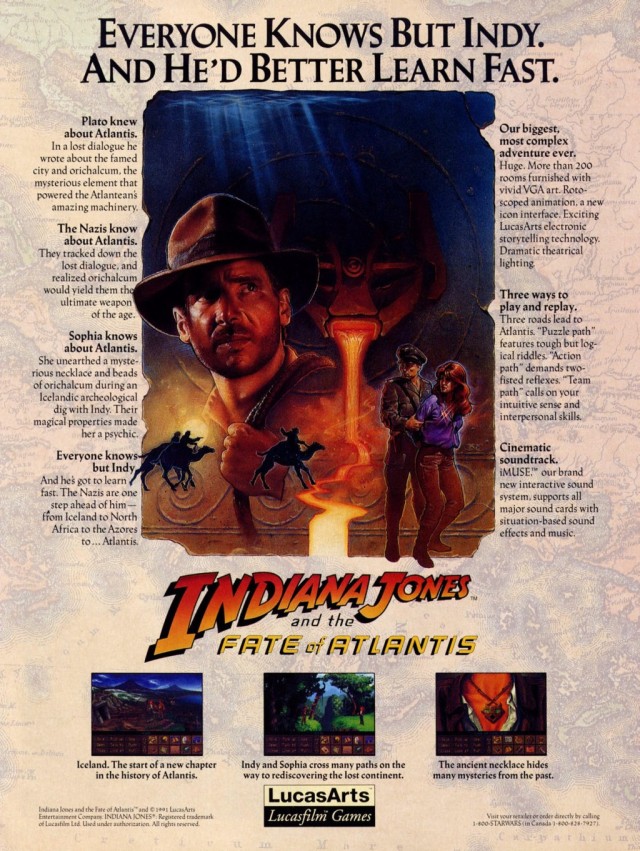This post has not been edited by the GamesBeat staff. Opinions by GamesBeat community writers do not necessarily reflect those of the staff.
LucasArts were one of the last few names to survive from what has arguably been one of gaming’s most exciting eras stretching from their founding during the 80s as players and programmers came to grips with the new medium and on through the 90s as PCs and consoles accelerated into the 3D age. Their history reads like a who’s who list of fantastic games crossing multiple genres.
They were a huge player in the PC market for more than a quarter of a century, a revolutionary and innovative engine that wasn’t afraid to take risks even through the last ten years or so when it became a house in which only Star Wars could afford the rent. Yet, early on, it was a company that seemed founded on the same spirit George Lucas brought to the silver screen with his imagination, daring to do tell tales and blow up stuff in exciting ways.
Fractal Fantasy
A surprise for me was that LucasArts’ first games weren’t based on Star Wars or any other Lucasfilm property when it was created as a group attached to the filmmaking company in 1982. It wasn’t even called LucasArts yet, only Lucasfilm Games.
But their early work defined the kind of innovative drive shared with Lucas and his SFX house, Industrial Light and Magic, pioneering techniques and design ideas that put them on the map. It seemed like the perfect blend of experts and ideas.
Their first games created 3D spaces using 2D graphics based on fractals. Rescue of Fractalus in ’84 was a space action sim turning players into pilots of a ship navigating around mountains on their way to rescue other pilots stuck on the hostile surface of a deadly planet.
The Eidolon in ’85 created 3D cave corridors filled with monsters and an Ikaruga-like mechanic in using your own projectiles to absorb others as a defense and power-up mechanic. Ballblazer in the same year was a futuristic 3D soccer-like game. Koronis Rift made players scavengers across the surface of another world, blowing away ancient defenses in search of scavenger paydirt.
In 1986, Labyrinth became the first movie game that the group would create as well as tie-in to project created by Lucasfilm and Jim Henson. It was unique in starting out as a text adventure. When Jareth, the Gobling King (played by David Bowie in the film and using his likeness for the game) appeared to kick things off, it pulled a Wizard of Oz Technicolor surprise in turning into a graphic adventure.
They had even dabbled with early, graphical MMO called Habitat. Imagine a 2D adventure game environment, only that every door and individual participating in it led to something new online. It was a pioneering, if short lived, piece of tech that found bits and pieces of its concept echoed later in properties from a young AOL to Second Life.
Meteors and Microwaves
The developer had also stepped into the realm of adventure gaming. Maniac Mansion in ’87 was nothing like a typical adventure at the time. This wasn’t anything like Sierra’s King’s Quest series.
It took place in a setting inspired by B movie cliches with multiple characters to control, mansion of strange characters, a mad scientist, and an evil meteor. It was tough, funny, weird, and a nice vacation from the usual adventure setting — much like Sierra’s own Space Quest a year earlier.
It was that kind of spirit that brought Secret of Monkey Island and its sequel to PCs everywhere and craftsmanship that made Indiana Jones’ Last Crusade and a wholly original story, Fate of Atlantis, celebrate some of his best hours in gaming ever. Even a story that was meant for Steven Spielberg’s short lived 80s TV series, Amazing Stories, found its way into The Dig in ’95 boasting writing credits that include Orson Scott Card and Infocom alum, Brian Moriarty. Moriarty’s name also appears in a brilliantly unique game from 1990 called Loom turning musical “drafts” into the language of adventure and magic.
Steve Purcell’s cartoony rabbit and dog team-up would result in the bizarre humor of Sam & Max Hit the Road whose manual contained a boardgame. An alternative America running on hovercars and motorcycles brought us Ben in Full Throttle. Day of the Tentacle would trip time in another fantastic, body swapping adventure as a sequel to Maniac Mansion. You get the picture. The adventure genre was never the same again.
X-Wings and Wunderwaffe
By 1990, the games division was organized into LucasArts, responsible for both publishing and developing its own titles as it had been doing. The 90s also saw not only an explosion of adventure games, but a synergy of genres centered on Star Wars. Leveraging their expertise with sims such as Lawrence Holland’s Battlehawks 1942 in ’88, Holland and his team would be responsible for one of the greatest space sim series in the genre’s history – X-Wing in ’93.
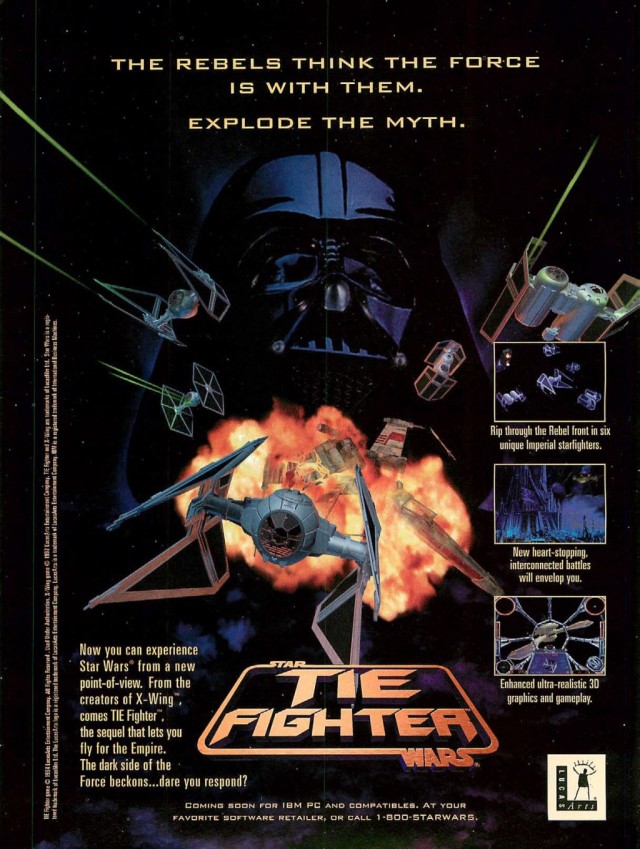
Above: TIE Fighter had a lot of things that made it one of the most exciting space sims ever made. It had a secret society, medals, and the power of the Star Wars license itself along with all the ships brought with it including those from the expanded materials outside of the films such as those in West End Games’ Star Wars PnP game. Even Timothy Zahn’s Grand Admiral Thrawn shows up to boss you around.
Totally Games is the name of Holland’s company and their long history centered on all things flight related for Lucasfilm Games, now LucasArts, from Battlehawks 1942 all the way up through Secret Weapons Over Normandy for the Xbox, PS2, and PCs.
But stitching together Star Wars and space sims, especially after the wild success of Origin’s Wing Commander, seemed like the next logical thing to do. People were hungry for that kind of arcade-like action in space, and what better way to celebrate it than with Star Wars?
X-Wing was challenging – it balanced arcade explosions against tough missions, clever AI, and resource management into each ship. 2D cockpits and effects were juxtaposed against 3D fighters and battlecruisers in the cold vacuum of space. Famous, and some not-so-famous, fighters filled its roster of targets and potential cockpits. Capital ships from the famous Corellian cruiser seen at the start of Episode IV to the menacing Star Destroyer chasing it rounded things out. And to cap things off, there was the Trench Run against the first Death Star. What was there not to like?
A year and two expansion packs later, TIE Fighter hit the scene in ’94 adding even more improvements to X-Wing in a dramatic turn as players fought for the Empire after the destruction of the first Death Star. The twist here is that it presented Imperial soldiers not as faceless enforcers of evil but a dedicated group of professionals convinced that they are all that stand between order and galactic anarchy. Pepper in a conspiracy or two, more new ships, more cutscenes, and better visuals, and it was a tremendously satisfying peek behind the Empire’s cannon fodder curtain.
I was pretty nervous flying around in a TIE fighter that had no shields, or as they call them, “flying eggshells”, breathing a sigh of relief when I finally upgraded to tougher models like the slightly overpowered TIE Defender. The “secret society” that players could rank up through as they pursued optional secondary objectives in a number of missions had also added additional motivation to go that extra risky mile. Between LucasArts and Origin at the time, the space combat genre was setting the stars on fire.
The X-Wing series, however, had its own share of bumps on the road. X-Wing vs. TIE Fighter was a multiplayer focused game with no campaign, something that was only remedied with an expansion (Balance of Power). However, by the end of the 90s, space sims were also on a rapid decline along with adventure games among the big developers and publishers. Even the solid X-Wing: Alliance and Volition’s Freespace titles weren’t enough to turn things around despite being critically lauded.
But LucasArts had also shown an adaptability to embrace new technology in forging another story for Star Wars – first-person shooters.
Hokey religions and ancient weapons are no match for a good blaster at your side, kid.
I remember reading from an old issue of PC Gamer that LucasArts had actually hired real-life architects to build the areas in their “Doom killer”, Dark Forces in 1995.
At the time, 1993’s Doom was all anyone talked about on PCs – it was id piling success atop success kicked off previously with their 3D remake of Muse Software’s Castle Wolfenstein. Two years after Doom had come out, anyone doing a 3D shooter after that was still somewhat unfairly labeled as trying to topple Doom from its throne. It was still the biggest gorilla on its respective block.
But LucasArts tried, and while X-Wing took to the stars as a space fighter sim and titles like Day of the Tentacle delivering punchline after punchline for adventurers, Dark Forces thrilled players in bringing the Star Wars universe down to a 3D shooter. I remember it as amazing stuff – seeing that neon green wireframe for the Death Star in the first mission was a thrilling moment along with finding out first-hand why Stormtroopers missed so often with their blasters.
The follow-ups, Jedi Knight and Jedi Knight II, embraced CDs with FMV cuts and full, poly modeled gameplay trading in (most of) Dark Forces’ 2D sprites for textured surfaces, lightsabers, and Light and Dark Force powers. The first Jedi Knight also made waves when it trapped players inside a falling, rolling, starship.
Jedi Knight’s expansion, Mysteries of the Sith, stood out in dramatic fashion for the uniquely non-violent solution at its climax. Other titles, such as Jedi Academy, would continue to push Star Wars’ 3D world. Yet by the end of the 90s and with the new prequels, LucasArts would begin spending more time focusing on only one thing.
Always in motion is the future
LucasArts’ history has also had its own ups and downs with bizarre titles that didn’t do quite as well. Casual desktop games, Indiana Jones and his Desktop Adventures in ’96 and Yoda Stories in ’97, attempted to substitute for Minesweeper and Solitaire on Windows machines with randomly generated mini-games. It also licensed a few games for consoles, whether it was a port for the on-rails shooter series, Rebel Assault, or Sculptured Software’s Super Star Wars, which were both pretty fun. Yet they didn’t quite enjoy the kind of PC-to-console success that they did early on with only the PC in the 80s and early 90s.
Force Commander, an RTS developed internally, was greeted with a lukewarm response from fans and critics, especially in competing against Westwood/EA’s Command & Conquer series. A sequel to Full Throttle, as recounted by Adventure Classic Gaming in a 2008 interview with Bill Tiller, was canceled not once but twice. And who could forget Masters of Teras Kasi. As popular as the fighting game genre was at the time, making a Star Wars game to grab a piece of it was probably not the best idea.
At the turn of the century, a more cautious LucasArts chose to focus primarily on Star Wars especially in the wake of the new prequels, a decision that Dean Takahashi illustrates here on VentureBeat as a key reason of why the fabled studio had as much trouble it did. Yet it also pointed out that others were also more than capable of doing the license justice. Petroglyph’s Star Wars: Empire at War or Pandemic’s Star Wars: Battlefront series were both solid and respectable titles in their own right..
Yet for gamers like me sifting through its past, is it any wonder why I and others held a glimmer of hope in seeing whether LucasArts could reclaim the kind of imaginative fury responsible for building a “Doom” killer or merging 3D aesthetics with brilliant storytelling in a title like Grim Fandango? I didn’t think Force Unleashed was that “bad” a game and Republic Commando was exciting stuff. Star Wars 1313’s grittiness hearkened back to when the Rebel Alliance took a chance on former Imperial officer, Kyle Katarn. That Lucas himself wanted it to revolve around Boba Fett makes it even more frustrating to wonder what could have been.
The fate of LucasArts is also something of a cautionary tale. Its focus on only one specific property, as Dean Takahashi had pointed out above, was as much a detriment to its long term health as it was a source of ready IP. It was simply unable to continue on as it had.
On the other hand, companies such as EA and Activision, with much deeper pockets, have narrowed their cash cows into a handful of specific lines that regularly churn out annual sequels that a ready audience is eager to eat up.
They also have early histories of cutting edge games in common, an attitude of creative strength that flowed from one title to the next setting the pace for others to follow. LucasArts’ early history, like that of EA and Activision, mirrors that of new developers today willing to push the envelope from CD Projekt to Telltale Games as they continue improving their craft.
The company that I knew was long gone before the end finally came, but the same spirit that drove it to tell a story as good as any Indy film or make a space sim accessible to anyone with a flight stick still lives on in many others today. Others continue to carry on that torch. I just kind of wish that LucasArts could have been among them.
